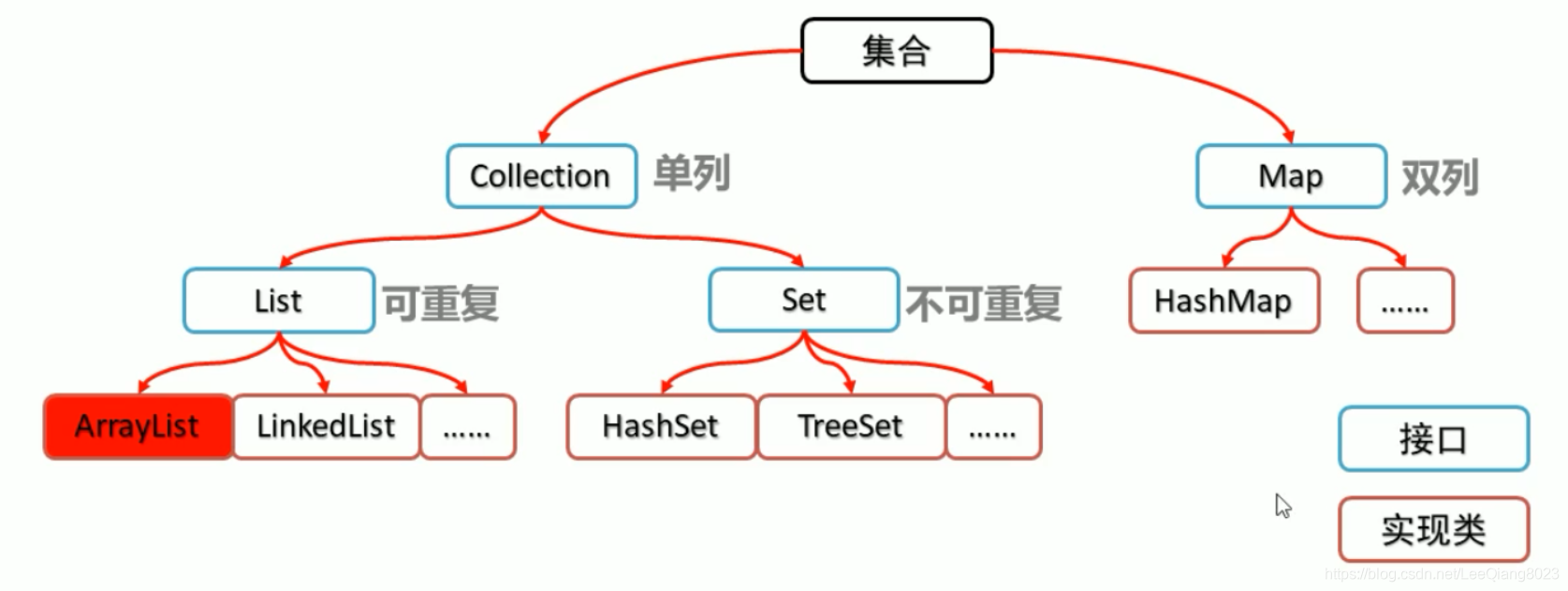1.Collection集合
1.1集合体结构【记忆】
- 集合类的特点
提供一种存储空间可变的存储模型,存储的数据容量可以随时发生改变 - 集合类的体系图

1.2Collection集合概述和基本使用【应用】
- Collection集合概述
- 是单例集合的顶层接口,它表示一组对象,这些对象也称为Collection的元素
- JDK不提供接口的任何直接实现,它提供更具体的子接口(如Set和List)实现
- Collection
public class CollectionDemo01{
public static void main(String[] args){
Collection<String> C = new ArrayList<String>();
c.add("hello");
c.add("world");
c.add("java");
System.out.println(c);
}
}
1.3Collection集合的常用方法【应用】
| 方法名 | 说明 |
|---|
| boolean add(E e) | 添加元素 |
| boolean remove(Object o) | 从集合中移除指定的元素 |
| void clear() | 清空集合中的元素 |
| boolean contains(Object o) | 判断集合中是否存在指定的元素 |
| boolean isEmpty | 判断集合是否为空 |
| int size() | 集合的长度,也就是集合中元素的个数 |
1.4Collection集合的遍历【应用】
- 迭代器的介绍
- 迭代器,集合的专用遍历方式
- Iterator iterator():返回此集合中元素的迭代器,通过集合的iterator()方法得到
- 迭代器是通过集合的iterator()方法得到的,所以说我们说它是依赖于集合而存在的
- Collection集合的遍历
public class IteratorDemo{
public static void main(String[] args){
Collection<String> c = new ArrayList<>();
c.add("hello");
c.add("world");
c.add("java")
c.add("javaee");
Iteratir<String> it = c.iterator();
while(it.hasNext()){
String s = it.next();
System.out.println(s);
}
}
}
1.5集合使用步骤图解【理解】

1.6集合的案例-Collection集合存储对象并遍历【应用】
- 案例需求:
创建一个存储学生对象的集合,存储3各学生对象,使用程序实现在控制台遍历该集合 - 代码实现
public class Student{
private String name;
private int age;
public Student() {
}
public Student(String name,int age){
this.name = name;
this.age = age;
}
public String getName() {
return name;
}
public void setName(String name){
this.name - name;
}
public int getAge() {
return age;
}
public void setAge(int age){
this.age = age;
}
}
public class CollectionDemo {
public static void main(String[] args){
Collection<Student> c = new ArrayList<Student>();
Student s1 = new Student("张三", 20);
Student s2 = new Student("李四", 21);
Student s3 = new Student("王二",22);
c.add(s1);
c.add(s2);
c.add(s3);
Interator<Student> it = c.iterator();
while (it.hasNext()) {
Student s = it.next();
System.out,println(s.getName() + "," + s.getAge());
}
}
}
2.List集合
2.1List集合概述和特点【记忆】
- List集合概述
- 有序集合(也称为序列),用户可以精确控制列表中每个元素的插入位置。用户可以通过整数索引访问元素,并搜索列表中的元素
- 与 Set集合不同,列表通常允许重复的元素
- List集合特点
2.2 List集合的特有方法【应用】
| 方法名 | 描述 |
|---|
| void add(int index, E element) | 在此集合中的指定位置插入指定的元素 |
| E remove(int index) | 删除指定索引处的元素,返回被删除的元素 |
| E set(int index,E element) | 修改指定索引处的元素,返回被修改的元素 |
| E get(int index) | 返回指定索引处的元素 |
2.3集合的案例-List集合存储学生对象并遍历【应用】
- 案例需求
创建一个存储学生对象的集合,存储3个学生对象,使用程序实现在控制台遍历该集合 - 代码实现
public class Student {
private String name;
private int age;
public Student() {
}
public void setName(String name) {
this.name = name;
}
public int getAge() {
return age;
}
public void setAge(int age) {
this.age = age;
}
}
public class ListDemo{
public static void main(String[] args) {
List<student> list = new ArrayList<Student>();
Student s1 = new Student("张三",20);
Student s1 = new Student("李四",21);
Student s1 = new Student("王二",222);
list.add(s1);
list.add(s2);
list.add(s3);
Iterator<Student> it = list.iterator();
while(it.hasNext()) {
Studetn s = it.next();
System.out.println(s.getName()+","+s.getAge());
for(int i=0; i<list.size;i++){
System.out.println(s.getName()+","+s.getAge());
}
}
}
2.4并发修改异常【应用】
- 出现的原因
迭代器遍历的过程中,通过集合对象修改了集合中的元素,造成了迭代器获取元素中判断预期修改值和事迹修改值不一致,则会出现:ConcurrentModificationException - 解决的方案
用for循环遍历,然后用集合对象做对应的操作即可 - 示例代码
public class ListDemo{
public static void main(String[] args){
List<String> list = new ArrayList<String>();
list.add("hello");
list.add("world");
list.add("java");
for(int i=0; i<list.size(); i++) {
String s= list.get(i);
if(s.equals("world")){
list.add("javaee");
}
}
System.out.println(list);
}
}
2.5列表迭代器【应用】
- ListIterator介绍
- 通过List集合的listiIterator()方法得到,所以说它是List集合特有的迭代器
- 用于允许程序员沿任一方向遍历的列表迭代器,在迭代器期间修改列表,并获取列表中迭代器的当前位置
-示例代码
public class ListIteratorDemo {
public static void main(String[] args){
List<String> list = new ArrayList<String>();
list.add("hello");
list.add("world");
list.add("java");
ListIterator<String> lit = list.listiIterator();
while(list.hasNext){
String s = lit.next();
if(s.equals("world")) {
lit.add("javaee");
}
}
System.out.println(list);
}
}
2.6 增强for循环【应用】
for(元素数据类型 变量名 :数组/集合对象名) {
循环体;
}
public class ForDemo {
public static void main(String[] args){
int[] arr = {1,2,3,4,5};
for(int i : arr) {
System.out.println(i);
}
String[] strArray = {"hello","world","java"};
for(String s : strArray) {
System.out.println(s);
}
List<Strins> list = new ArrayList<String>();
list.add("hello");
list.add("world");
list.add("java");
for(String s : list) {
System.out.println(s);
}
}
}
2.7集合的案例-List集合存储学生对象三种方式遍历【应用】
- 案例需求
创建一个存储学生对象的集合,存储3个学生对象,使用程序实现在控制台遍历该集合 - 代码实现
public class Student {
private String name;
private int age;
public int age;
public Student() {
}
public Student(String name,int age) {
this.name = name;
this.age = age;
}
public String getName() {
return name;
}
public void setName(String name) {
this.name = name;
}
public int getAge() {
return age;
}
public void setAge(int age){
this.age = age;
}
}
public class ListDemo
public static void main(String[] args) {
List<Student> list = new ArrayList<Studet>();
Studnet s1 = new Student("张三",20);
Studnet s2 = new Student("李四",21);
Studnet s3 = new Student("王二",22);
list.add(s1);
list.add(s2);
list.add(s3);
Iterator<student> it = list.iterator();
whlie(it.hasNext){
Student s = it.netx();
System.out.println(s.getName()+","+s.getAge());
}
for(int i=0; i<list.size(); i++){
Student s = list.get(i);
System.out.println(s.getName()+","+s.getAge());
}
for(Student s : list) {
System.out.println(s.getNmae()+","+s.getAge());
}
}
}
3.数据结构
3.1数据结构之栈和队列【记忆】
3.2数据结构之数组和链表【记忆】
4.List集合的实现类
4.1List集合子类的特点【记忆】
- ArrayList集合
底层是数据结构实现,查询快,增删慢 - LinkedList集合
底层是链表结构实现,查询慢,增删快
4.2集合的案例-ArrayList集合存储学生对象三种方式遍历【应用】
- 案例需求
创建一个存储学生对象的集合,存储3个学生对象,使用程序实现在控制台遍历该集合 - 代码实现
public class Student {
private String name;
private inr age;
public Student() [
}
public Student(String name, int age) {
this.name = name;
this,age = age;
}
public String getName(){
return name;
}
public void setName(String name){
this.name = name;
}
public int getAge(){
return age;
}
public void setAge(int age){
this.age = age;
}
public class ArrayListDemo{
public static void main(Strintg[] args){
4.3 LinkedList集合的特有功能【应用】
| 方法 | 说明 |
|---|
| public void addFirst(E e) | 在该列表开头插入指定的元素 |
| public void addLast(E e) | 将指定的元素追加到此列表的末尾 |
| public E getFirst | 返回此列表中的第一个元素 |
| public E getLast | 返回此列表中的最后一个元素 |
| public E removeFirst() | 从此列表中删除并返回第一个元素 |
| public E removeLast() | 从列表中删除并返回最后一个元素 |




 浙公网安备 33010602011771号
浙公网安备 33010602011771号